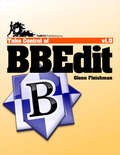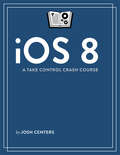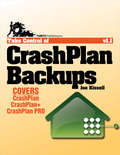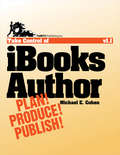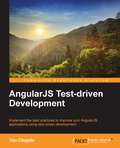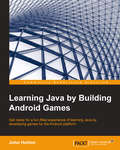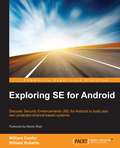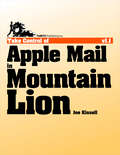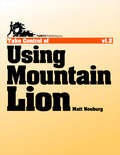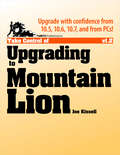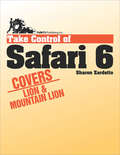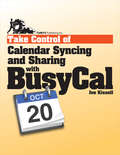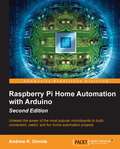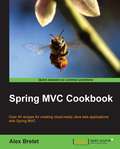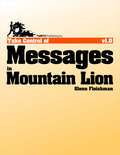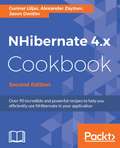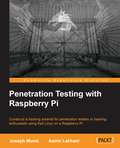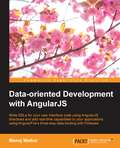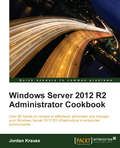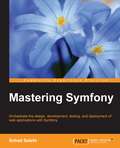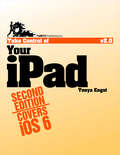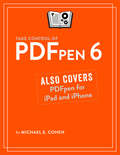- Table View
- List View
Take Control of BBEdit
by Glenn FleishmanRead this 199-page ebook to learn how to: Set up BBEdit for maximum efficiency: Configure key standard and expert preferences for optimal usage. Sync BBEdit settings and support files between Macs using Dropbox. Create text factories that automate sequences of text processing commands. Create "clippings" of boilerplate text, complete with dynamic placeholders. Use Dropbox or a version control system to track versions of documents. Start work on the right track: Collect multiple resources--including files, folders, and URLs--into a single project window. Use BBEdit's many options for opening and saving files. Work with remote files via BBEdit's FTP/SFTP browser windows. Type faster, search better, and automate repetitive bits: Control BBEdit with keyboard shortcuts. Write faster with text completion of words, code snippets, HTML tags, and more. Clean up text with spurious tabs, incorrect case, gremlin characters, and more. Search for and replace text across multiple documents at once. Learn how to use grep pattern matching for powerful searches. Write in Markdown, and preview Markdown documents. Compare and collaborate effectively: Discover best practices for commenting and revision tracking. Compare multiple versions of documents. Run your Web site like a wizard: Create HTML and CSS files using BBEdit's effective, extensive markup tools. Preview dynamic pages locally with user-defined preview templates. Clean up old or badly coded Web pages. Build Web sites using templates and includes. Connect BBEdit to Fetch, Interarchy, or Transmit to edit remote files. Maintain Web sites in BBEdit using four different workflows.
iOS 8: A Take Control Crash Course
by Josh CentersLearn iOS 8 essentials quickly and get more out of your iPad or iPhone!In this iOS 8 Crash Course, you'll quickly master new (and old) features in iOS. Guided by TidBITS Managing Editor Josh Centers, you'll get an overview of iOS 8's new capabilities along with directions for putting them to use right away. In addition to explaining system features like Siri, Spotlight, and Notification Center, Josh helps you explore the new Health app, plus discover what's different in iOS 8's most-changed apps: Camera, Phone, Photos, Mail, Messages, and Safari. Additional special topics cover accessibility, privacy, important apps to try, managing data usage, and improving battery life.You'll find answers to questions like these:How do I install a third-party keyboard, like Smile's TextExpander?How do I use iCloud Photo Sharing in Share sheets?What do I tap to send a voice message in Messages?Should I turn on iCloud Photo Library?What do I ask Siri in order to identify currently playing music?If I share my location in a group chat, is it shared with the chat or the people?How does the 2-minute delete feature work for media in Messages?How do I get quick access to Evernote and other apps in Notification Center?Where did the search field and toolbar go in Safari?How do I connect 1Password and Instapaper with Safari?Which feature should I turn on to make buttons easier to see?How do I hook apps into Apple's new Health app?Which apps are hogging my battery?How do I tell Siri who my mother is so I can call her by saying "Call Mom"?In Family Sharing, what should I expect from the Ask to Buy feature?How do I find those cool Flyover tours in Maps?How do I tell my iPhone to stop tracking my location?How can I enable/disable the Zoom screen magnifier quickly?How do I minimize an email message that I'm writing so I can check something else in Mail and then come back to it easily?Crash course? As part of our new Crash Course series, this book splits the first-rate content you expect from us into short chunks so you can dip in and read quickly. Because so many Take Control readers provide tech support to others, each concise chapter has sharing buttons and practical tweet-tips, making it easy to freely share a few pages with Facebook friends, Twitter followers, and others who really need the information. Take Control Crash Courses have a modern, magazine-like layout in PDF while retaining a reflowable design in the EPUB and Mobipocket.
Take Control of CrashPlan Backups
by Joe KissellIn the ebook, backup expert Joe Kissell helps you devise an effective backup strategy for CrashPlan's unique capabilities, shows you how to back up to multiple destinations and restore files from all of them, explains less-common tasks (such as switching to a new computer and seeding a hard drive locally before moving it to a friend's house for offsite backup), and walks you through fine-tuning CrashPlan's many settings to meet your needs. All three consumer and small-business versions of CrashPlan - the free CrashPlan and the subscription-focused CrashPlan+ and CrashPlan PRO - are discussed, with relevant differences called out. (The book does not cover CrashPlan PROe, the enterprise version.) For small businesses subscribing to the CrashPlan PRO service, Joe documents how to manage users and computers via the service's Web-based interface, and for anyone backing up to CrashPlan Central or CrashPlan PRO Cloud, he describes how to use the CrashPlan Mobile app (for iOS, Android, and Windows Phone 7) to access backed-up files. Lastly, Joe provides troubleshooting tips in case things go wrong, and offers advice for backup needs outside CrashPlan's purview (like bootable duplicates). Questions answered in the book include: Can I get by with just the free CrashPlan or do I need CrashPlan+? How does CrashPlan protect my data in transit and at the destination? Does CrashPlan maintain multiple versions of files? Can I control how many? How does CrashPlan work to reduce bandwidth use and storage space? Can I back up to a local hard disk, to a friend, and to CrashPlan Central? How do I back up different sets of files to different destinations? How can I speed up my first Internet-based backup? How can I tell what CrashPlan is doing, and what do all its messages mean? What's involved with restoring files, even older versions of files? What do I do if I need to restore all my files over a slow Internet connection? How can I avoid backup confusion when I switch to a new computer? How do I seed a backup for offsite or CrashPlan Central use? How can I pause or stop CrashPlan's background processing? In what ways can I tweak CrashPlan's settings for optimal performance? How can CrashPlan notify me if backups aren't working for some reason? What can I do with my backed-up files via the free CrashPlan Mobile app?
Take Control of iBooks Author
by Michael E CohenApple's Multi-Touch ebooks boast visually impressive, template-driven layouts that can contain many types of interactive media--including interactive images, slideshows, audio and video files, rotating 3D images, and quiz questions. You create them on your Mac in the free iBooks Author application from Apple, and you can sell them to iPad users in the iBookstore or distribute them for free in any way you like. Read this ebook for expert advice on how to: Plan Your Project! Give your content a "spine," and design it to flow comfortably into an iBooks Author template. Determine what special types of media your book will contain--including audio files, video files, slideshows, charts and tables, graphics, interactive graphics, 3D rotating graphics (COLLADA), and study questions. You'll learn what your options are, and what file formats are needed. Decide whether to write your text in iBooks Author or in another program--and, if you decide to write outside of iBooks Author, learn how to import your content efficiently. Produce Your Book! Pick an iBooks Author template and customize it--you'll learn about the dependencies and interactions between the portrait view layout and the landscape view, and find specific advice and steps for customizing both types. Add new chapters, sections, and pages to your book. Make your text flow through your book, and understand how to control the flow. Import and position graphics, videos, and other media items, so that they appear where you want them to--and understand why and how these elements may appear as thumbnails. Make an imported graphic interactive with tappable elements that reveal additional information. Create and configure study questions (and answers). Add an interactive glossary and index, and understand how they interact. Learn how iBooks Author generates a table of contents, and tweak your table of contents. Make internal hyperlinks and external links to the Web. Publish! Export your ebook as a basic PDF or text file (for people who want to read your book, but don't have an iPad). Export your ebook as a Multi-Touch ebook that can be read exclusively in iBooks on the iPad. Get set up to make your ebook available through Apple's iBookstore. Upload your completed project to the iBookstore.
Take Control of Apple Mail in Lion
by Joe KissellThis book will teach you to: Comprehend account options: You'll come to understand the difference between POP and IMAP, plus learn about special aspects of iCloud, Exchange, and Gmail accounts. You'll discover how to integrate all these types of accounts, and more, into your overall Mail setup, as well as learn how you can manage Gmail's labels in an IMAP environment. Read: We know you know how to read, but you'll learn efficient ways to quickly open, read, process, and file your messages. You'll see how best to use Lion's three-pane display layout (or turn it off if you prefer), and how to follow email threads and conversations. You'll also get tips for handling incoming attachments, flagging messages, avoiding spam, and using Mail's built-in RSS feed reader. Write and send: You'll learn different methods for quickly addressing your email, how to take control of the From, To, Cc, and Bcc lines, and how to create multiple signatures. You'll also find out about how to address a single message to a group of recipients, and how to decide whether you should use digital signatures or encryption, plus what to do when you want to send a digitally signed or encrypted message. Also, you'll find out how to format an email message--and why you might not want to, plus learn how to include URLs, add attachments, and include quoted text from other messages. Find your stuff: You'll find advice on how to organize Mail's sidebar, Favorites bar, and your various mailboxes so you can easily locate messages using a variety of techniques--including search tokens and Boolean expressions. Joe covers simple features, such as making a new mailbox or rearranging your mailboxes, as well as advanced techniques, such as creating rules and smart mailboxes. Use Notes: Mail has a Notes feature for leaving yourself reminders. Learn the strengths and limitations of Notes, and make it work for you. Unravel Mail mysteries: Understand the sometimes-present Outbox, sort out the Dock unread count, learn why smart addresses can be stupid, avoid "unsafe" addresses, manage the Previous Recipients list, wrangle attachments, find your notes, and determine why certain mailboxes appear in particular categories on Mail's sidebar. Avoid and fix problems: Get advice on how to back up your email, and find out how to restore it from a backup. Also read the dozen pages of hard-won troubleshooting advice with tips on managing a misbehaving mailbox, fixing sending problems and delays, fixing connection errors, and more.
AngularJS Test-driven Development
by Tim ChaplinThis book is for developers who want to learn about AngularJS development by applying testing techniques. You are assumed to have a basic knowledge and understanding of HTML, JavaScript, and AngularJS.
Learning Java by Building Android Games
by John HortonIf you are completely new to either Java, Android, or game programming and are aiming to publish Android games, then this book is for you. This book also acts as a refresher for those who already have experience in Java on another platforms or other object-oriented languages.
Automating Microsoft Azure with PowerShell
by John Chapman Aman DhallyThis book is designed to help administrators and developers better automate Azure management tasks. No prior knowledge of PowerShell is required.
Exploring SE for Android
by William Confer William RobertsThis book is intended for developers and engineers with some familiarity of operating system concepts as implemented by Linux. A basic background in C code would be helpful. Their positions range from hobbyists wanting to secure their Android powered creations to OEM engineers building handsets to engineers of emerging areas where Android is seeing growth.
Take Control of Apple Mail in Mountain Lion
by Joe KissellJoin Joe as you become confident with how to: Comprehend account options: Understand the difference between POP and IMAP, plus learn about special aspects of iCloud, Exchange, and Gmail accounts. Discover how to integrate all these types of accounts, and more, into your overall Mail setup, as well as learn how you can manage Gmail's labels in an IMAP environment. Read: Learn efficient ways to quickly open, read, process, and file your messages. Build your know-how of Mountain Lion's new VIP options for identifying important messages and take control of which messages appear as notifications. See how best to use three-pane view (or turn it off if you prefer), and how to follow email threads and conversations. You'll also get tips for handling incoming attachments, flagging messages, avoiding spam, and using Mail's built-in RSS feed reader. Write and send: Discover different methods for quickly addressing your email; how to handle the From, To, Cc, and Bcc lines; and how to create multiple signatures. Find out how to address a single message to a group of recipients, and how to decide whether you should use digital signatures or encryption, plus what to do when you want to send a digitally signed or encrypted message. And, get advice about formatting an email message--and why you might not want to, plus learn how to include URLs, attachments, and quoted text from other messages. Find your stuff: Keep Mail organized with advice on how to arrange Mail's sidebar, Favorites bar, and your various mailboxes so you can easily locate messages using a variety of techniques--including search tokens and Boolean expressions. Joe covers simple features, such as making a new mailbox and rearranging your mailboxes, as well as advanced techniques, such as creating rules and smart mailboxes. Unravel Mail mysteries: Understand the sometimes-present Outbox, sort out the Dock unread count, learn why smart addresses can be stupid, avoid "unsafe" addresses, manage the Previous Recipients list, wrangle attachments, and determine why certain mailboxes appear in particular categories on Mail's sidebar. Avoid and fix problems: Get advice on how to back up your email, and find out how to restore it from a backup. Also read the dozen pages of hard-won troubleshooting advice with tips on managing a misbehaving mailbox, fixing sending problems and delays, resolving connection errors, and more.
Take Control of Using Mountain Lion
by Matt NeuburgYou'll become comfortable with these important Mountain Lion features: Notifications: Learn how to view, organize, and control your notifications--so that they don't control you! Gatekeeper: Understand the new Gatekeeper security system, and how you can bypass it when necessary. Resume: Enjoy the Resume feature that re-opens applications and windows when you restart your Mac or relaunch a program. Or learn how to shut it off. Auto Save: Some applications don't have Save commands in Mountain Lion! Learn how to save if you need to, and what to do if OS X saves something you don't want--and discover a new option in Mountain Lion that refines Auto Save in an important way. iCloud: Read what Matt thinks is interesting about iCloud, plus come to a full understanding of how to work with Documents in the Cloud in OS X--including how to handle the new Open dialog. Window management: Get help with resizing your windows, find out about full-screen mode, and go way beyond the basics with Mission Control and desktop spaces. Gestures: If you have a trackpad or Magic Mouse, get ready for more gestures in Mountain Lion! You'll learn how handle these core customizations: Menu bar: Enable (or disable) menu icons at the right side of the menu bar, and locate the elusive checkbox for making the menu bar look solid. Finder windows: Set up the default Finder window in a smart way that suits your needs. Dock: Take control of your Dock's appearance, location, and contents. Launchpad: Move and remove items in Launchpad--a close cousin to the iOS Home screen--and make "folders" that contain multiple apps. Screen: Calibrate your screen so it looks good to you, and learn how to make choppy text look smoother. Desktop: Set which elements appear on the Desktop, and pick a custom background image. Plus you'll find the answers to these customization-related questions: How do I turn off notification banners and alerts, for all my applications, all at once? Where did my scrollbars go? How do I make the text in my Finder window sidebar larger? How do I change the size of my mouse pointer icon? How do I create a custom keyboard shortcut for a menu item? Chockablock with information, the ebook also teaches you how to: Activate the new Voice Dictation feature. Issue the nifty keyboard shortcut for the handy Accessibility Options dialog. Find missing or deeply buried files quickly. Enter accented characters--or type in a different language! Install, delete, and organize fonts. Let your fingers do the walking by choosing menu items with the keyboard. Type a shortcut to "spring" open a closed folder while dragging a file onto it. Set up a new user account--and limit its powers. Zoom with picture-in-a-picture. Find your hidden user Library--and keep it found. ...and much more!
Take Control of Upgrading to Mountain Lion
by Joe KissellIn particular, you'll learn how to: Manage iCloud: During your Mountain Lion installation, you'll be asked for an Apple ID, but should you enter one? And, if you have more than one, which one? You'll find advice for sorting out your Apple ID before you enter the installer. Upgrade from Tiger or Leopard: How will you download the installer from the Mac App Store on one of these Macs? What about Rosetta for PowerPC-based apps? Joe answers these questions and discusses the special challenges you'll encounter when trying to upgrade efficiently from 10.4 Tiger or 10.5 Leopard. Handle Your Hardware: Check for Mountain Lion compatibility, clear extra files and software off your disk, and test your Mac to be sure all the hardware and disks are running properly--better to discover and correct a problem now than on upgrade day. Deal with duplication: Learn why having a duplicate of your hard disk is essential before installing Mountain Lion, and how to make one. Also, get help with backing up a Windows volume, should you be running Windows on your Mac via Boot Camp. Consider a few geeky details: If you secure your data and documents with disk encryption now, or would like to under Mountain Lion, get advice on what to do before you upgrade and learn why Joe likes Apple's FileVault 2. Also, read what Joe thinks of partitioning and what you might want to do about it before installing. Do the upgrade: Run the Mountain Lion installer, choosing all the optimal settings and options for your computer and tastes, and make sure all your personal data is still in place afterward. Perform post-installation tasks: You're not done when the installer is - be sure to run Software Update, set up necessary user accounts, and (perhaps) turn on FileVault and Time Machine. You'll find help with troubleshooting any problems that may have occurred with your upgrade. Go beyond the basics: Joe even covers topics such as the basics of installing Mountain Lion Server; moving from an older Mac to a newer one that already has Mountain Lion installed; and using Recovery mode to fix disk problems, reinstall Mountain Lion, and perform other maintenance tasks.
Take Control of Safari 4
by Sharon ZardettoRead this book to learn answers to questions like these: How do I load six Web pages at once? Now that I've loaded six pages, how do I best work with them? What are all the keyboard shortcuts for working with tabs? How do I bookmark a page I want to return to? How do I import Firefox bookmarks? I have 1,042 bookmarks. Is there a sensible way to search or organize them? What are the default keyboard shortcuts for the bookmarks bar? Can I search for text on the currently active Web page? How do I erase my history to prevent someone snooping through it? Where does Safari store Web site user names and passwords? Help! However Safari stored my password, it doesn't work any more! How do I use Safari to read RSS headlines from different sites? How do I "snip" a Web page to make it into a Dashboard widget?
Take Control of Calendar Syncing and Sharing with BusyCal (1.0)
by Joe KissellIs there anything more embarrassing than missing an appointment due to a calendar misstep? (Yes. Showing up late, in your pajamas.) Operating calendar software isn't hard, but if you don't understand how calendars sync among devices, how you can share calendars with other people, and how meeting notices work, it's all too easy to fall prey to problems. The goal of this brief ebook, then, is to explain how calendar servers and clients work, when and why to use iCloud or Google Calendar for syncing and sharing, and how to construct a sensible calendar strategy for BusyCal 2 on your Mac—even if you also use other calendar apps or share calendars with people who do. Author Joe Kissell also guides you toward practices that will make your life easier and tries to dissuade you from those that will add unnecessary complication.
Raspberry Pi Home Automation with Arduino - Second Edition
by Andrew K. DennisIf you are new to the Raspberry Pi, the Arduino, or home automation and wish to develop some amazing projects using these tools, then this book is for you. Any experience in using the Raspberry Pi would be an added advantage.
Zabbix Network Monitoring Essentials
by Andrea Dalle Vacche Stefano Kewan LeeIf you are an experienced network administrator looking for a comprehensive monitoring solution that will keep a watchful eye on networks, then this book is for you.
Spring MVC Cookbook
by Alex BretetOver 40 recipes for creating cloud-ready Java web applications with Spring MVC About This Book * Configure Spring MVC to build logic-less controllers that transparently support the most advanced web techniques * Build an amazing social and financial application that applies microservices patterns on deployment, self-testability, interoperability, cloud architectures, and scalability * Fast-paced, practical guide to learn how to set up Spring MVC to produce REST resources and templates as required by the latest front-end best practices Who This Book Is For If you are an experienced Java developer, with prior experience in web technologies, and want to step up in your career and stay up-to-date or learn more about Spring Web scalability, this book is for you. What You Will Learn * Structure your project with Maven and create self-tested, domain-specific deployable web archives * Generate templates for a responsive and powerful frontend with AngularJS and Bootstrap * Build a high performance stateless RESTful and hypermedia application to support your multiple customer experiences * Authenticate over REST with a BASIC authentication scheme and OAuth2; handle roles and permissions * Document and publish your REST API using Swagger and Swagger UI * Scale your Spring web application * Communicate through WebSocket and STOMP messages * Provide support to your application and efficiently maintain its business features with a relevant test stack In Detail Spring MVC is a lightweight application framework that comes with a great configuration by default. Being part of the Spring Framework, it naturally extended and supported it with an amazing set of recognizable annotations. External libraries can be plugged in and plugged out. It also possesses a request flow. Complete support of REST web services makes the Spring architecture an extremely consistent choice to support your front-end needs and Internet transformations. From the design of your Maven modules, you will achieve an Enterprise-standard for a stateless REST application based on Spring and Spring MVC with this book. This guide is unique in its style as it features a massive overview of practical development techniques brought together from the Spring ecosystem, the new JEE standards, the JavaScript revolution and Internet of Things. You will begin with the very first steps of Spring MVC's product design. Focused on deployment, viability, and maintainability, you will learn the use of Eclipse, Maven, and Git. You will walk through the separation of concerns driven by the microservices principles. Using Bootstrap and AngularJS, you will develop a responsive front-end, capable of interacting autonomously with a REST API. Later in the book, you will setup the Java Persistence API (JPA) within Spring; learn how to configure your Entities to reflect your domain needs, and discover Spring Data repositories. You will analyze how Spring MVC responds to complex HTTP requests. You will implement Hypermedia and HATEOAS to guide your customer's stateless conversation with the product and see how a messaging-service based on WebSocket can be configured. Finally you will learn how to set up and organize different levels of automated-tests, including logging and monitoring. Style and approach A comprehensive, recipe-based guide to creating stunning Java apps with Spring MVC as a result of learning and implementing pro-level practices, techniques, and solutions.
Take Control of Messages in Mountain Lion (1.0)
by Glenn FleishmanWith this ebook in hand, you'll discover: * What is difference between SMS, instant messaging, and iMessage - plus why you'd care. * How to convert your iChat experience to the brave new world of Messages. * Why it is that Messages lets you communicate via accounts at five different services (plus Bonjour), and how to figure out which you should use. * In an iMessage account, how to configure which email address(es) and iPhone phone number(s) should receive messages on your Mac. * How to use Google Talk with Google two-factor authentication. * How to send messages - and set your online status - with an eye to etiquette and conventions. * What an instant-message buddy is, why it's awkward that iMessage doesn't have buddies, and how to add buddies, organize buddies, and even delete or block a buddy. * How to exchange photos, videos, business documents, and other files via Messages. * The best way to add a spoken conversation or video to a chat, whether through an iMessage/FaceTime chat or an instant-messaging service. * How to view and control the Mac screen of the person you're chatting with (or vice-versa). * And much more...
NHibernate 4.x Cookbook - Second Edition
by Jason Dentler Alexander Zaytsev Gunnar LiljasOver 90 incredible and powerful recipes to help you efficiently use NHibernate in your application About This Book • Master the full range of NHibernate features through detailed example recipes that you can quickly apply to your own applications • Reduce hours of application development time and get a better application architecture and improved performance • Create, maintain, and update your database structure automatically with the help of NHibernate Who This Book Is For This book is written for .NET developers who want to use NHibernate and those who want to deepen their knowledge of the platform. Examples are written in C# and XML. Some basic knowledge of SQL is assumed. If you build .NET applications that use relational databases, this book is for you. What You Will Learn • Create a persistent object model to move data in and out of your database • Build the database from your model automatically • Configure NHibernate for use with WebForms, MVC, WPF, and WinForms applications • Create database queries using a variety of methods • Improve the performance of your applications using a variety of techniques • Build an infrastructure for fast, easy, test-driven development of your data access layer • Implement entity validation, auditing, full-text search, horizontal partitioning (sharding), and spatial queries using NHibernate Contrib projects In Detail NHibernate is a mature, flexible, scalable, and feature-complete open source project for data access. Although it sounds like an easy task to build and maintain database applications, it can be challenging to get beyond the basics and develop applications that meet your needs perfectly. NHibernate allows you to use plain SQL and stored procedures less and keep focus on your application logic instead. Learning the best practices for a NHibernate-based application will help you avoid problems and ensure that your project is a success. The book will take you from the absolute basics of NHibernate through to its most advanced features, showing you how to take full advantage of each concept to quickly create amazing database applications. You will learn several techniques for each of the four core NHibernate tasks—configuration, mapping, session and transaction management, and querying—and which techniques fit best with various types of applications. In short, you will be able to build an application using NHibernate by the end of the book. You will also learn how to best implement enterprise application architecture patterns using NHibernate, leading to clean, easy-to-understand code and increased productivity. In addition to new features, you will learn creative ways to extend the NHibernate core, as well as gaining techniques to work with the NHibernate search, shards, spatial, envers, and validation projects. Style and approach This book contains recipes with examples organized in functional areas, each containing step-by-step instructions on everything necessary to execute a particular task. The book is designed so you can read it from start to end or just open up any chapter and start following the recipes.
Penetration Testing with Raspberry Pi
by Joseph Muniz Aamir LakhaniIf you are looking for a low budget, small form-factor remotely accessible hacking tool, then the concepts in this book are ideal for you. If you are a penetration tester who wants to save on travel costs by placing a low-cost node on a target network, you will save thousands by using the methods covered in this book. You do not have to be a skilled hacker or programmer to use this book. It will be beneficial to have some networking experience; however, it is not required to follow the concepts covered in this book.
Data-oriented Development with AngularJS
by Manoj WaikarThis book helps beginner-level AngularJS developers organize AngularJS applications by discussing important AngularJS concepts and best practices. If you are an experienced AngularJS developer but haven't written directives or haven't created custom HTML controls before, then this book is ideal for you.
Windows Server 2012 R2 Administrator Cookbook
by Jordan KrauseThis book is intended for system administrators and IT professionals with experience in Windows Server 2008 or Windows Server 2012 environments who are looking to acquire the skills and knowledge necessary to manage and maintain the core infrastructure required for a Windows Server 2012 and Windows Server 2012 R2 environment.
Mastering Symfony
by Sohail SalehiOrchestrate the designing, development, testing, and deployment of web applications with Symfony About This Book * Create a robust and reliable Symfony development pipeline using Amazon's cloud platform * Cut development and maintenance costs by defining crystal clear features and possible scenarios for each feature before implementation * Follow detailed examples provided in each chapter to create a task management application Who This Book Is For If you are a PHP developer with some experience in Symfony and are looking to master the framework and use it to its full potential, then this book is for you. Though experience with PHP, object-oriented techniques, and Symfony basics is assumed, this book will give you a crash course on the basics and then proceed to more advanced topics. What You Will Learn * Install and configure Symfony and required third-party bundles to develop a task management application * Set up a continuous integration server to orchestrate automatic builds every time you add a new feature to your project * Reduce maintenance costs dramatically using Behaviour Driven Development (BDD) * Create a slick user interface using the Bootstrap framework * Design robust business logic using Doctrine * Build a comprehensive dashboard and secure your project using the Sonata project * Improve performance using Redis, Memcache, and Varnish * Create customized Symfony commands and add them to your console In Detail In this book, you will learn some lesser known aspects of development with Symfony, and you will see how to use Symfony as a framework to create reliable and effective applications. You might have developed some impressive PHP libraries in other projects, but what is the point when your library is tied to one particular project? With Symfony, you can turn your code into a service and reuse it in other projects. This book starts with Symfony concepts such as bundles, routing, twig, doctrine, and more, taking you through the request/response life cycle. You will then proceed to set up development, test, and deployment environments in AWS. Then you will create reliable projects using Behat and Mink, and design business logic, cover authentication, and authorization steps in a security checking process. You will be walked through concepts such as DependencyInjection, service containers, and services, and go through steps to create customized commands for Symfony's console. Finally, the book covers performance optimization and the use of Varnish and Memcached in our project, and you are treated with the creation of database agnostic bundles and best practices. Style and approach A step-by-step guide to mastering Symfony while developing a task management application. Each chapter comes with detailed examples.
Take Control of Your iPad
by Tonya EngstTonya walks you through the entire iPad experience: Handle the hardware: Learn about the hardware components in your iPad model that make it unique, and get ideas for which accessories you should considering purchasing. Also, see where all the ports and buttons are on your iPad, plus find out how to turn it on and off, and how to reset and restore in case of a problem. For iPad 2 and third-generation iPad users, the ebook also describes how to use the camera for photos and videos, or to place a FaceTime video call. Get started: Learn how to answer the questions asked by the iPad's Setup Assistant, and get help with important configuration options that the Setup Assistant doesn't cover, including security, Bluetooth, tethering, Picture Frame slideshows, and notifications. You'll also find detailed directions for managing a Wi-Fi or USB-based iTunes sync. Sync data wirelessly: Find advice for integrating your iPad with iCloud, Google Contacts and Calendars, and Microsoft Exchange. (The ebook has solid iCloud coverage, but for all the details, read Take Control of iCloud.) Get around: Learn the most important gestures, and find out how to type on the iPad's virtual keyboard, with advice on typing faster, as well as how to copy and paste. For third-generation iPad users, the ebook describes the new Voice Dictation feature. Make the Home screen feel like home: Find friendly guidance on customizing the Home screen and Dock, making folders, and managing the multitasking bar. Get organized: Learn how to send email and exchange text messages; run the Calendar and Contacts apps; and use Maps, Find My Friends, and Find My iPad. Enjoy media: Discover how to find and read ebooks and magazines, enjoy music and movies, listen to podcasts and audiobooks, browse the Web, use iTunes U, and generally become an iPad media maven. Add apps: Read real-world advice on locating, purchasing, downloading, configuring, organizing, and sharing third-party apps.
Take Control of PDFpen 6
by Michael E CohenLearn to create, edit, and manipulate PDFs with Smile's PDFpen 6!Have you ever needed to give feedback on a PDF, but stumbled around trying to insert comments and proofreading marks? Or spent way too long trying to refresh the date on a PDF-based flyer? Maybe you wanted to fill out and sign a PDF-based form without printing it and faxing it back? What about making your own PDF-based form with fill-in fields that could be submitted over the Internet? Or have you wished you could OCR scanned text so you could revise it right in the PDF? All these tasks--and much more--can be done with PDFpen from Smile.Even better, there's an in-depth guide for all these tasks. Written by Michael E. Cohen with clarity and humor, Take Control of PDFpen 6 turns you into a PDF productivity powerhouse while you work at your desktop or laptop Mac with PDFpen or PDFpenPro, or on the go with your iPad or iPhone.Michael begins with a rundown of your purchasing options: PDFpen versus PDFpenPro, from Smile versus the Mac App Store, and the advantages of an iPhone or iPad version. Next, you'll meet PDFpen, starting with a general overview of the PDF format, followed by a tour of PDFpen's user interface--including the new Editing bar. Then Michael jumps into the many ways you can modify a PDF:Add and remove pages, and combine pages from multiple files into one PDF.Directly edit the text, plus add comments and professional editing marks.Redact confidential text. Add clickable page and URL links, add page numbers, and add images.Make a clickable table of contents (PDFpenPro only).Change the look with a Quartz filter (for example, make it black-and-white).Reduce the file size with a Quartz filter.Password-protect it.Turn it into a formatted Microsoft Word document.Prevent other users taking certain actions, such as printing or editing (PDFpenPro only).You'll learn how PDFpen is your friend when it comes to forms:Fill out forms with ease.Add a handwritten signature--in the iOS versions, you can write with a stylus!Print just form entries on a pre-printed form!Create an interactive PDF form for both Mac and Windows (PDFpenPro only). You can even make your interactive PDF form collect data and send it to you via email or the Web.And, that's not all! You'll also learn how to:Move PDFs in and out of PDFpen in iOS, so that you can fluidly share them between your Apple devices--Michael describes several approaches, including iCloud, iTunes, Dropbox, and Open In.Get the most out of Apple's AutoSave and Versions features--or turn them off for PDFpen if you find them troublesome.Scan a document to PDF, and make the text editable with OCR.Print a PDF with its annotations appearing at the end.Store frequently used items (like a logo or signature) in the PDFpen Library.Turn a Web site into a multi-page PDF (PDFpenPro only).An appendix describes the many useful AppleScripts that ship with PDFpen.This ebook was created in collaboration with Smile, with PDFpen's developers tech editing the manuscript.
